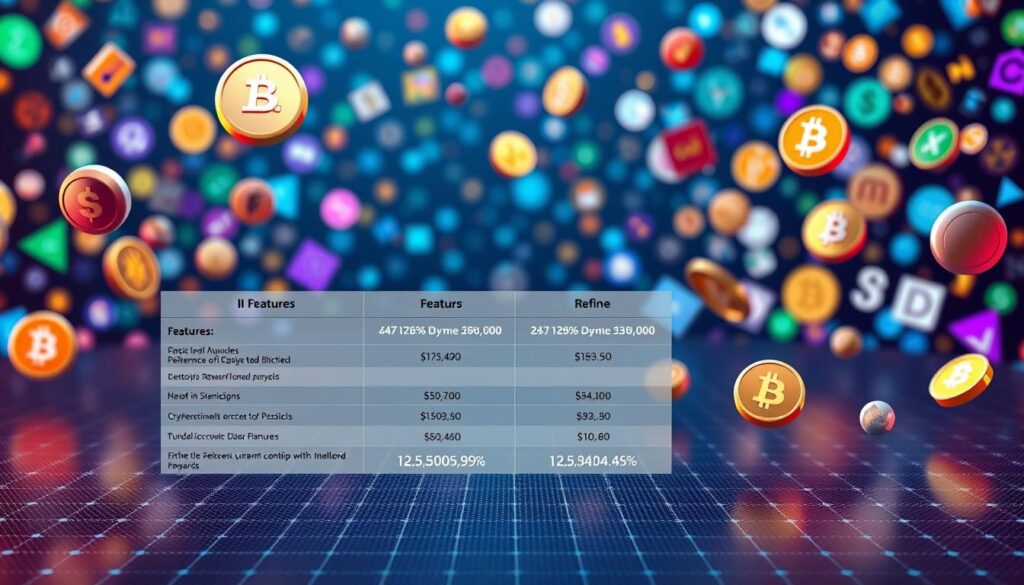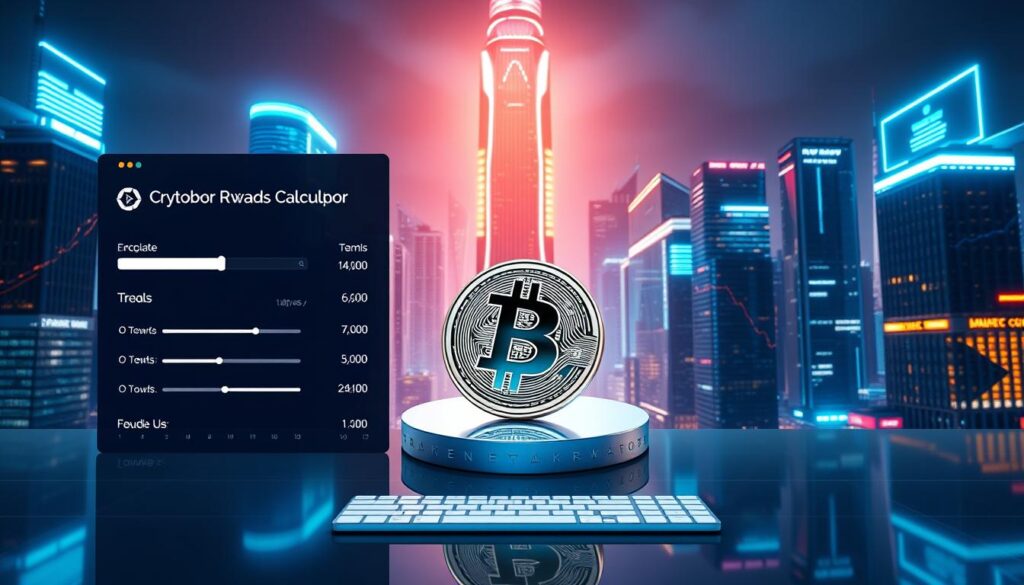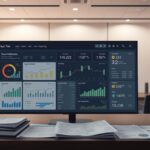Now Reading: Top Crypto Mining Hardware for U.S. Enthusiasts
- 01
Top Crypto Mining Hardware for U.S. Enthusiasts
Top Crypto Mining Hardware for U.S. Enthusiasts
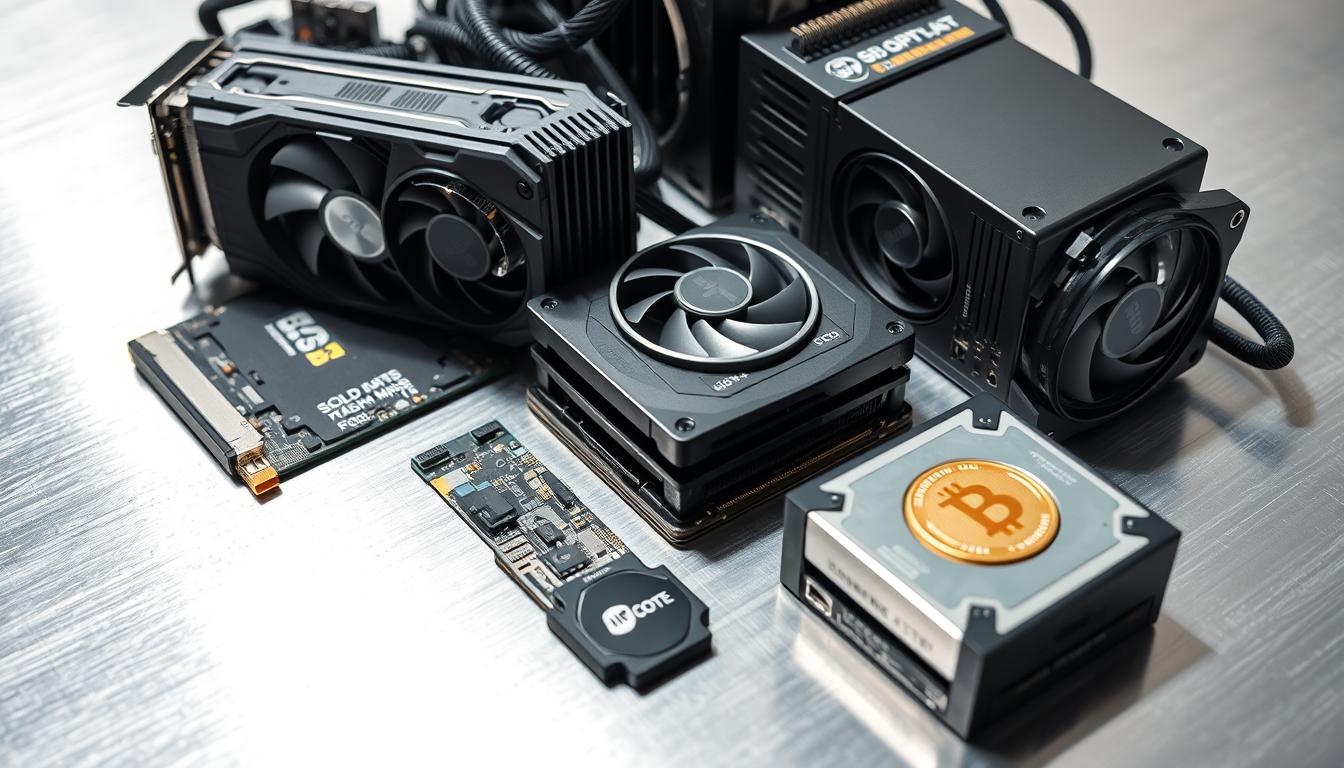
In 2023, the crypto mining world opens new doors for U.S. fans. Picking the right gear is key to making money in a tough market. This guide shows the best crypto miners and tips for American miners, keeping in mind local rules and energy costs.
Things like electricity prices and how well the hardware works really matter. You’ll learn how to pick mining setups that offer good value over time. For beginners, knowing which coins to mine—like Bitcoin or Ethereum—is important. Check out this resource for the best coins for passive income.
U.S. miners need to think about local energy prices and rules. This guide looks at how these factors affect choosing mining gear, from ASICs to GPUs. It helps make sure choices fit local conditions. Whether you’re after high performance or something affordable, making smart choices is crucial for lasting success.
Key Takeaways
- Selecting hardware impacts profitability and compliance with U.S. regulations.
- Top-rated crypto miners must balance performance and energy efficiency.
- Electricity costs vary by state, influencing hardware ROI calculations.
- Beginners should prioritize hardware suited to popular mineable coins.
- Regulatory changes and hardware lifespan affect long-term mining viability.
Understanding Crypto Mining Fundamentals
Crypto mining is key to blockchain networks, turning computer power into digital assets. Before picking best crypto mining hardware reviews, learn how it connects to hardware performance and profit.
How Cryptocurrency Mining Works
Miners compete to solve complex puzzles to secure transactions. Those who succeed add new blocks to the chain, earning rewards. This process needs specific hardware like ASICs for Bitcoin or GPUs for Ethereum, each handling different algorithms.
Efficient high-performance mining rigs can solve more puzzles per second. This increases the chance of earning rewards.
Mining Difficulty and Network Hashrates Explained
The network’s difficulty adjusts to keep mining pace steady. Higher difficulty means faster hardware is needed. Bitcoin’s network hashrate, measured in exahashes, shows the power needed to stay profitable.
Check real-time hashrate data to avoid buying outdated equipment.
Proof of Work vs. Proof of Stake
- Proof of Work (PoW): Requires energy-intensive hardware. Bitcoin and Litecoin rely on this, making ASICs essential.
- Proof of Stake (PoS): Uses validators staking coins instead of solving puzzles. Ethereum’s shift to PoS reduced demand for mining gear, reshaping hardware needs.
Understanding these mechanisms helps match hardware to protocol requirements. PoW coins still favor best crypto mining hardware reviews. Meanwhile, PoS eliminates the need for physical rigs.
Current Mining Landscape in the United States
The U.S. has become a top player in crypto mining since China’s 2021 crackdown. States like Texas, Washington, and Wyoming are now hubs for mining. They offer cheap energy and support for mining. Top mining equipment brands in the USA do well here, thanks to stable rules and good infrastructure.
- Texas: Low electricity rates and deregulated energy markets attract large-scale facilities.
- Washington: Hydropower and tax incentives make it ideal for energy-intensive hardware.
- Wyoming: Clear crypto asset laws and no state income tax draw operators.
Regulatory clarity varies by state. Wyoming and Texas have laws that recognize crypto as property, making things safer. But, states like New York have stricter rules. Big investors are leading the way, with companies like Marathon and Riot Blockchain growing fast. They focus on top picks for mining hardware in the U.S. for better performance and growth.
More miners are turning to solar and wind power to save money. But, a global chip shortage has delayed getting new hardware. This has made GPUs and ASICs more expensive. As the field changes, miners must balance costs, location, and equipment quality to stay ahead.
Factors to Consider When Selecting Mining Hardware
Choosing the right mining hardware is about finding a balance. You need to think about performance, cost, and how easy it is to use. The best crypto mining hardware for U.S. enthusiasts should match your goals and setup.
Hashrate Performance and Power Efficiency
First, look at the hashrate (MH/s or TH/s) and how much energy it uses. For example, Bitmain’s Antminer S19 Pro has 110 TH/s and uses 3,250W. It’s important to check how many watts it uses per terahash to see how efficient it is.
Being efficient means you’ll spend less on electricity. This is especially true in places like West Virginia, where electricity is cheap, compared to California, where it’s more expensive.
Initial Investment vs. Long-term Returns
- ASICs cost a lot upfront ($3,000–$10,000) but can give steady returns for coins like Bitcoin.
- GPUs are cheaper but not as good for mining coins. Use best crypto mining hardware benchmarks to figure out when you’ll break even.
Noise Levels and Heat Management
If you’re mining at home, you’ll want quiet hardware. Look for devices that are under 60 dB. For places like Arizona or Texas, where it’s hot, choose hardware that can handle the heat well.
Having a good plan for ventilation is key for mining at home.
Warranty and Customer Support
Big names like MicroBT and Canaan offer warranties of 12–18 months. Make sure there are repair centers near you in the U.S. Bitmain, for example, has 24/7 support. Stay away from hardware that doesn’t have good support.
Best Crypto Mining Hardware for U.S. Enthusiasts in 2023
Choosing the right mining gear depends on your budget, power access, and what you want to mine. Here’s a breakdown of proven options for every level of miner.
Top-Performing ASIC Miners
For SHA-256 coins like Bitcoin, the Bitmain Antminer S19 XP is a top choice. It has 110 TH/s at 3,073 W. The MicroBT WhatsMiner M30S++ offers 114 TH/s. Both are available in the U.S. through Genesis Mining and come with 12-month warranties.
Prices start at $9,000, with ROI projections under $0.10/kWh.
High-End GPU Mining Rigs
- NVIDIA RTX 4090: 80MH/s on Ethereum with 450W power draw
- AMD Radeon RX 7900 XT: Strong X11/X16 algorithm performance
Pair these with high-capacity PSUs from Corsair or Seasonic for stable operation. Pre-built rigs from brands like DeepGreen offer turnkey setups starting at $3,500.
CPU Mining Options for Beginners
CPU mining is still viable for algorithms like CryptoNight. The AMD Ryzen 7 5800X achieves 1,200 H/s on Monero at 105W. Starter kits with compatible motherboards cost under $1,200, making them ideal for testing profitability without large investments.
Research local electricity rates using sites like PowerCostMonitor.com to optimize costs. Review real-world feedback from U.S. miner forums to align hardware choices with current market conditions.
ASIC Miners: The Professional’s Choice
Cutting-edge ASIC miners are the top choice for professionals. They offer unmatched efficiency for certain cryptocurrencies. Unlike general-purpose hardware, these devices focus on single algorithms, maximizing returns for dedicated miners.
Brands like Bitmain, MicroBT, and Canaan lead the market. They produce high-performance mining rigs. These rigs prioritize power efficiency and hash rates.
- Bitmain’s Antminer S19 XP delivers 110 TH/s at 3,250W, optimized for Bitcoin mining.
- MicroBT’s Whatsminer M50S Plus features 123 TH/s with advanced cooling systems.
- Canaan’s AvalonMiner A1246 provides 89 TH/s in a compact form factor.
Installing these systems requires robust infrastructure. Many models need 220V power supplies and industrial cooling. This is to handle 75–90 dB noise levels.
In the U.S., miners often choose third-party hosting facilities. These facilities offer reliable 24/7 operation. Contracts usually last from 12–36 months, ensuring stable performance in competitive markets.
Financial planning is crucial for long-term success. ASIC lifespan averages 12–18 months before efficiency declines. Monitoring energy costs and algorithm updates helps maintain profitability.
Regular upgrades and strategic partnerships with U.S. suppliers are key. They help stay ahead of market shifts.
GPU Mining Rigs: Versatility and Adaptation
GPU mining rigs are great for U.S. miners who want flexible setups. Unlike ASICs, graphics cards can mine many cryptocurrencies. This makes them perfect for changing market needs.
Top choices like NVIDIA’s RTX 4080 and AMD’s RX 7900 series are very efficient. They balance power use and mining speed well for coins like Ethereum or Monero.
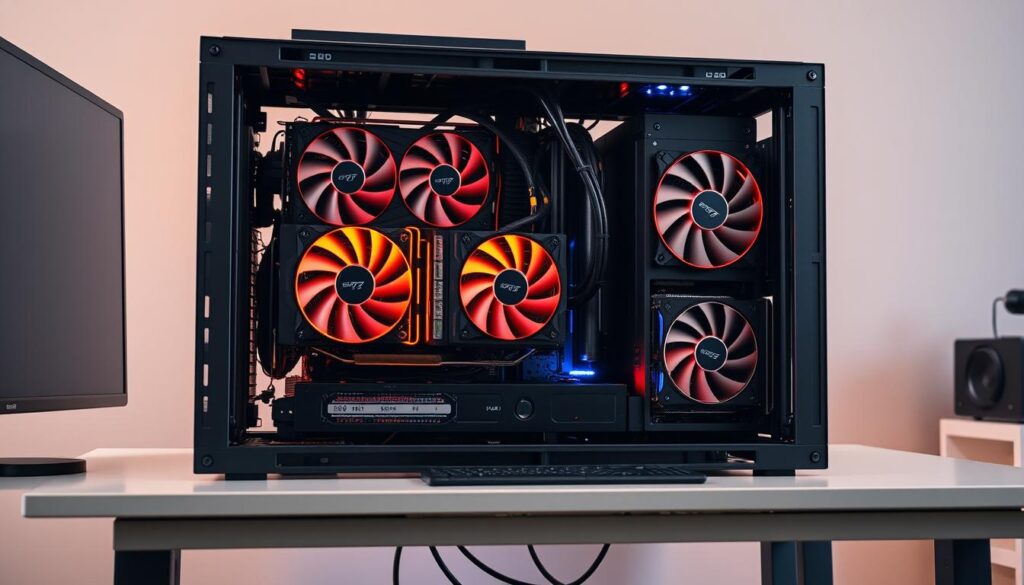
Top Graphics Cards for Multi-Coin Mining
- NVIDIA RTX 4080: Excels in Ethash algorithms, delivering 80-90 MH/s at 300W.
- AMD RX 7900 XT
, strong on Kawpow and Autolykos2, hitting 55-65 MH/s.
Check best crypto mining hardware reviews to compare efficiency metrics and profitability calculators.
Build or Buy?
Building your own rig can save 15-20% compared to pre-built high-performance mining rigs from brands like Mining Cave or Parallel Miner. DIYers save on costs but need to know about power supplies and airflow.
Pre-built options from vendors like GPUrisers offer warranties and easy algorithm changes.
Cooling Strategies for Optimal Performance
Small setups do well with open-air racks for good airflow. Bigger operations might use immersion cooling tanks or grow tents to keep cool. Always choose 80+ Titanium PSUs and 120mm fans for stable temperatures.
Budget-Friendly Mining Hardware Options
Starting with crypto mining doesn’t need a big budget. Affordable mining hardware solutions are available for those in the U.S. who want to try it out without spending too much. You can start with setups under $1,000 and still make money if you have cheap electricity.
For beginners, look at budget ASICs like the Antminer U3 or the Goldshell Mini series. These are energy-efficient and offer good hash rates at lower costs. You can also use single-GPU rigs with cards like the NVIDIA RTX 3060. These are great for mining Ethereum or other algorithms.
- Entry-Level Picks: Antminer U3 (under $300), Goldshell G1 Mini, or secondhand GPUs from eBay
- Used Hardware Tips: Check for wear-and-tear, verify hash rate specs, and look for sellers with return policies
- Repurpose Existing Gear: Use gaming PCs with software like NiceHash or Minergate during idle hours
Used markets offer chances but need careful attention. Sites like MinerMarketplace or CoinGeek have listings that need careful review. You might face missing warranties and lower performance for cheaper prices. For those who want to start small, using old hardware can turn it into a way to earn money. Just remember, you’ll make less money than with a dedicated setup.
Setting Up Your Mining Operation: Essential Components
Creating a successful crypto mining setup is more than just the top-rated crypto miners. You also need power, networking, and environmental controls. Start with a strong power system using top mining equipment brands in the USA like Bitmain or MicroBT. Make sure your circuits can handle high amperage.
- Networking: High-speed Ethernet switches from Netgear or Cisco are key to avoid lag. A backup router keeps your connection steady.
- Physical Layout: Rack mounts from Raritan or APC save space. Shelving should balance airflow and ease of access.
- Monitoring: Smart plugs from Sense or Enervee track energy use. Tools like NiceHash monitor performance from afar.
- Environment: Industrial fans from Delta or Liebert keep systems cool. Dehumidifiers protect hardware in humid areas.
Commercial-grade cooling systems from ClimateMaster keep temperatures right. Check local electrical codes for 110V/220V needs. Fire suppression systems like Kidde guard against overheating.
Match top mining equipment brands in the USA with quality parts for better uptime. Regularly check wiring and clean fans from dust. Choose safety-certified hardware for long-term success and profit.
Power Consumption Considerations and Electricity Costs in Different U.S. Regions
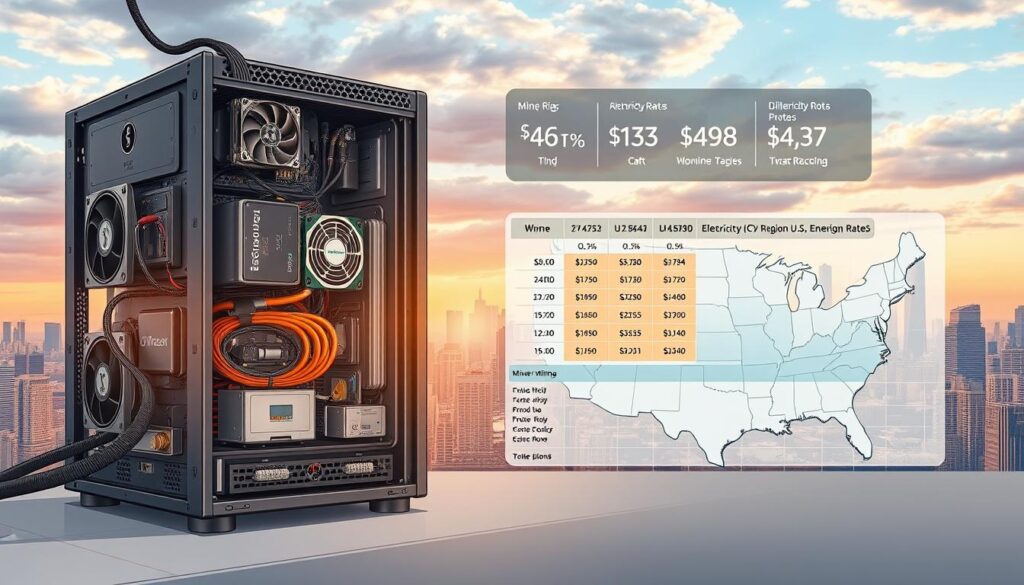
Electricity costs change a lot in the U.S., so where you are matters a lot. Places with low rates and lots of green energy are best for mining. Look at the rates and green energy in your area first.
States with the Most Favorable Electricity Rates
Washington, Idaho, and Texas have the lowest rates. They use a lot of hydroelectric power and have open markets. Texas, for example, lets miners get low rates from different providers.
Use the U.S. Energy Information Administration’s data to find the best place for your mining gear.
Renewable Energy Options for Sustainable Mining
- Solar panels: Put them in sunny places like Arizona or Texas for big savings.
- Wind energy: Texas and Oklahoma have wind farms you can use through utility programs.
- Green tariffs: Programs like Xcel Energy’s Windsource in Colorado give 100% green power at good rates.
Studies show solar in Arizona can save 30% over five years. Tax breaks like the ITC help with the cost of green energy.
Calculating Your Break-Even Point Based on Power Costs
Use this formula: Profit = (Hashrate * Revenue per Hash) – (Power Use * kWh Rate). Tools like WhatToMine and CryptoCompare’s calculators help with this. For example, a 2000W rig in Washington vs. California can save $200 a month.
Always test your mining gear to find the most energy-efficient models.
Legal and Regulatory Considerations for U.S. Miners
For crypto miners, following federal and state laws is key. The IRS sees mined cryptocurrency as taxable income. This means keeping detailed records of rewards and expenses is crucial.
Miners must also follow SEC rules for pool operations. Additionally, FinCEN’s MSB registration rules apply if needed.
State policies differ a lot. Texas and Wyoming are great for miners with low taxes and few rules. But, New York has banned proof-of-work mining until 2025. Always check local zoning laws before setting up your equipment. Some places have rules about noise or power use.
- Wyoming: No state crypto taxes, supportive for large-scale operations.
- Texas: Low electricity costs and business-friendly regulations.
- New York: Moratorium on certain mining activities until 2025.
Choosing an LLC can protect your assets. Keep track of your mining equipment and operational costs. Use accounting tools to document depreciation and electricity expenses for taxes.
Legal advisors who know crypto can help with rule changes. Stay updated with IRS publications and state websites. Resources like the Chamber of Digital Currency offer guidance on adapting to new rules. By focusing on compliance, miners can optimize their equipment without worrying about legal issues.
Mining Pools and Software for U.S.-Based Operations
Optimizing crypto mining needs reliable pools and secure software. U.S. enthusiasts should look for platforms with local servers. They should also find tools that work well with their hardware. This guide will help with pools, software, and security steps to protect your operations.
Top Mining Pools with U.S. Servers
Choose pools with U.S. servers to cut down on latency. Here are some key options:
- F2Pool: Supports Bitcoin, Ethereum, and Litecoin with U.S. nodes. Fees start at 0.2%, and payouts occur every 12 hours.
- Foundry USA: Specializes in Bitcoin mining with U.S.-based data centers. Fees are 1% plus transaction fees.
- Slush Pool: Offers Ethereum and Bitcoin mining with transparent payouts. U.S. servers ensure stable connections for GPU and ASIC setups.
Mining Software for Hardware Types
Software must match your hardware. Here are some options:
- ASIC Miners: Use BFGMiner for Bitcoin or Braiins OS for Antminer models.
- GPU Rigs: HiveOS manages multi-GPU setups, while XMRig optimizes Monero mining on NVIDIA/AMD cards.
- Beginners: Awesome Miner simplifies configuration for all hardware types, including the best crypto mining hardware for U.S. enthusiasts.
Security Considerations for Mining Software
Protect your operations with these steps:
- Enable two-factor authentication (2FA) for all accounts.
- Use hardware wallets like Ledger or Trezor to store crypto offline.
- Install firewalls to block unauthorized access to rigs.
- Monitor software logs for unusual activity using tools like Fail2Ban.
Regular software updates and encrypted connections prevent data breaches. Secure setups ensure top-rated crypto miners maintain profitability without risks.
Maintenance Tips to Extend Your Mining Hardware Lifespan
Cutting-edge ASIC miners and high-performance mining rigs need regular care. Dust can cut cooling by 30% or more. Cleaning is key.
Use canned air to clear vents weekly. Gently wipe fan blades with a soft brush. Never use water near electronics.
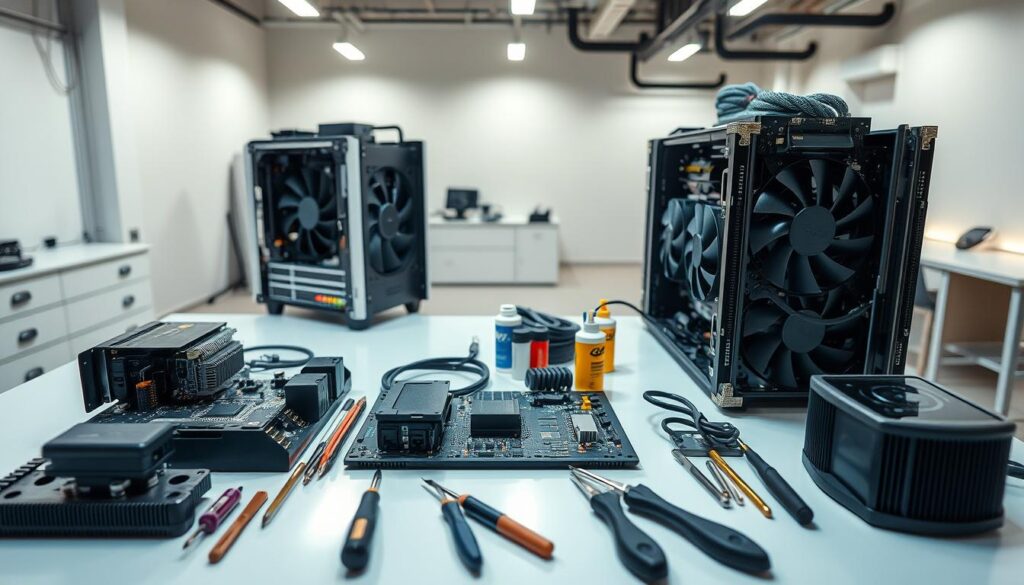
- Temperature control: Keep ASICs below 45°C (113°F) and GPUs under 75°C (167°F) with calibrated sensors.
- Replace thermal paste annually on GPU cores to maintain heat transfer.
- Check ASIC fan rotations monthly—grinding noises signal bearing failure. Replace faulty fans immediately.
In humid places like Florida, use dehumidifiers to stop corrosion. Dry areas like California need static-free storage. Use silica gel packets during seasonal shutdowns.
Update firmware for cutting-edge ASIC miners every quarter via manufacturer portals like Bitmain’s official tools. Test power supplies quarterly with multimeters—voltages outside rated specs indicate impending failure. Log all maintenance in cloud drives for easy tracking.
Seasonal storage requires disconnecting all power sources. Store GPUs in antistatic bags and ASICs in sealed containers. Power-on devices monthly for 30-minute cycles to prevent capacitor decay. Professional servicing every 18 months through brands like MicroBT’s certified technicians ensures long-term reliability.
Future-Proofing Your Mining Investment in an Evolving Crypto Landscape
Staying ahead in cryptocurrency mining means keeping up with changes. As big blockchains like Ethereum move to Proof of Stake, miners need to be flexible. Choosing the right mining hardware, like ASICs for Bitcoin or versatile GPUs, is crucial.
Looking for affordable options, like secondhand ASICs or energy-efficient rigs, can save money. This way, you don’t have to spend too much on one device.
Having different types of hardware is important. Using Bitcoin ASICs with GPUs lets miners work on various coins. Always check the latest models, like those in this guide.
Also, watch the resale market for valuable gear. Choose brands with good support.
Make extra money with heat recovery systems or hosting deals. Use stablecoins to protect against price swings. Keep an eye on new rules through industry forums. Focus on hardware that lasts and can grow with the market.
FAQ
What is the best crypto mining hardware for U.S. enthusiasts?
For U.S. enthusiasts, top choices include the Bitmain Antminer S19 XP and the MicroBT Whatsminer M30S. These ASIC miners are known for their high performance and energy efficiency. For GPU mining, NVIDIA’s RTX 3080 is a versatile option that works well with many currencies.
How do I determine the mining profitability of different hardware?
To check mining profitability, look at hashrate, power use, and local electricity costs. Use online calculators that consider current crypto prices, mining difficulty, and your hardware’s efficiency.
What factors should I consider when choosing mining hardware?
Key factors include hashrate, power efficiency, initial cost, and long-term returns. Also, consider noise levels and warranty terms. This helps match your hardware with your budget and mining goals.
Are there affordable mining hardware solutions available?
Yes, affordable options include entry-level ASIC miners under
FAQ
What is the best crypto mining hardware for U.S. enthusiasts?
For U.S. enthusiasts, top choices include the Bitmain Antminer S19 XP and the MicroBT Whatsminer M30S. These ASIC miners are known for their high performance and energy efficiency. For GPU mining, NVIDIA’s RTX 3080 is a versatile option that works well with many currencies.
How do I determine the mining profitability of different hardware?
To check mining profitability, look at hashrate, power use, and local electricity costs. Use online calculators that consider current crypto prices, mining difficulty, and your hardware’s efficiency.
What factors should I consider when choosing mining hardware?
Key factors include hashrate, power efficiency, initial cost, and long-term returns. Also, consider noise levels and warranty terms. This helps match your hardware with your budget and mining goals.
Are there affordable mining hardware solutions available?
Yes, affordable options include entry-level ASIC miners under $1,000 and single-GPU rigs. Used mining gear is also a budget-friendly choice, but be aware of potential longevity issues.
How does electricity cost affect mining operations in the U.S.?
Electricity costs are crucial for mining profits. States like Texas and Washington have lower rates due to renewable energy. Knowing your break-even point based on local rates is key for profit.
What are the best practices for maintaining my mining hardware?
Regular maintenance is vital. Clean dust, monitor temperature and humidity, and replace thermal paste as needed. Keeping your setup organized and secure also boosts efficiency and safety.
What is the role of mining pools in crypto mining?
Mining pools combine power to increase mining success and rewards. Joining a reputable U.S. pool can offer stable income, especially for solo miners with limited hardware.
How can I future-proof my mining investment?
Stay updated on trends like Proof of Stake. Diversify your hardware and plan for upgrades. Engage with the crypto community and keep learning to stay ahead in the changing market.
,000 and single-GPU rigs. Used mining gear is also a budget-friendly choice, but be aware of potential longevity issues.
How does electricity cost affect mining operations in the U.S.?
Electricity costs are crucial for mining profits. States like Texas and Washington have lower rates due to renewable energy. Knowing your break-even point based on local rates is key for profit.
What are the best practices for maintaining my mining hardware?
Regular maintenance is vital. Clean dust, monitor temperature and humidity, and replace thermal paste as needed. Keeping your setup organized and secure also boosts efficiency and safety.
What is the role of mining pools in crypto mining?
Mining pools combine power to increase mining success and rewards. Joining a reputable U.S. pool can offer stable income, especially for solo miners with limited hardware.
How can I future-proof my mining investment?
Stay updated on trends like Proof of Stake. Diversify your hardware and plan for upgrades. Engage with the crypto community and keep learning to stay ahead in the changing market.


